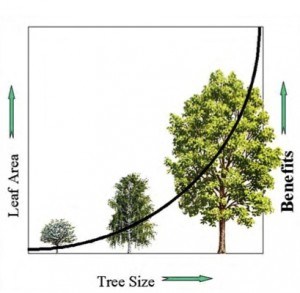The San Joaquin Valley suffers from urban heat island (UHI)
affect; pavement and other dark-colored surfaces throughout the Valley absorb
sunlight, trapping heat and increasing local temperatures. This adversely
affects local air quality as well as energy efficiency capabilities, energy
consumption, public health, climate resilience, and quality of life, among
other measures. Furthermore, the SJV not only generates its own pollutant
emissions, but is also impacted by transport of pollutants around the Valley
and from the Bay Area. Although air quality in the region is slowly improving, SJV Counties still have
not met federal ambient air quality standards for pollutants such as PM2.5
and PM10 as well as 8-hour ozone.
There is no better (and cheaper!) solution to both increasing energy efficiency and reducing greenhouse gas (GHG) emissions than protecting and expanding our existing tree canopies and developing additional canopies. In addition, trees provide extensive water, economic and crime reduction benefits to urban areas.
There is a clear need for mitigation policies. Increasing tree growth in parks and making use of open non-green space, such as medians, public streets and plazas, by expanding tree canopies and creating a landscape in which jurisdictions understand how and why urban canopies are so important and beneficial will improve energy efficiency, local temperature and air quality, minimizing adverse effects of greenhouse gas emissions and urban heat island effect.
 |
| This is an ideal canopy, no? |
Native, drought-tolerant trees will not only thrive in
our region, but also contribute to necessary air quality improvement and
widespread cooling, especially in summer months. Tree canopies sequester CO2,
reducing the amount of greenhouse gases in the atmosphere. They are
natural air conditioners, shading and cooling both buildings and streets and
reducing summer temperatures of and, therefore, cooling costs for the entire tree-lined
neighborhood or community. Trees also provide windbreak, reducing heating costs, and absorb sounds, greatly reducing noise pollution.
 |
| Greater the canopy, greater the benefits. |
Additionally, streets and medians lined with trees require significantly less watering than those with grass. Trees help capture rainfall and
recharge aquifers through filtering water through their roots. This also
contributes to reduced storm water runoff, decreasing potential flooding, storm
water management costs and flow of polluted water.
Drought
conditions shouldn't stop the planting of trees. A lack of tree
canopy will not only negatively contribute to issues such as poor air and water quality, but
the continued loss of trees due to forest fire, bark beetle infestations and
bacterial infections, such as fireblight, will
worsen these effects on the local communities.
There is a clear need for mitigation policies. Increasing tree growth in parks and making use of open non-green space, such as medians, public streets and plazas, by expanding tree canopies and creating a landscape in which jurisdictions understand how and why urban canopies are so important and beneficial will improve energy efficiency, local temperature and air quality, minimizing adverse effects of greenhouse gas emissions and urban heat island effect.
Do you like the sound of this? Stick around for Part II where I will describe benefits in greater detail!
No comments:
Post a Comment